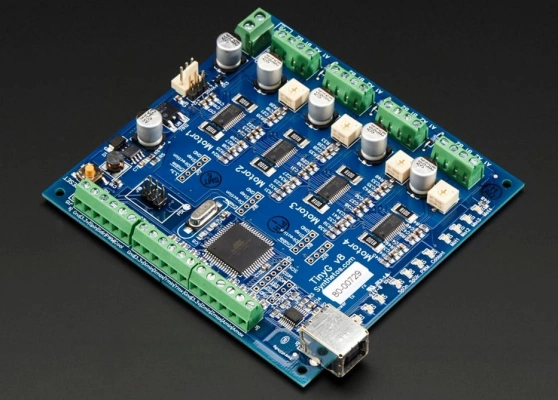OUTLINE:
An Ultimate Guide: What Is A CNC Controller
 116
116A CNC controller is the brain of the CNC machine tool, which is responsible for receiving instructions from the programming software and converting these instructions into mechanical actions. At the heart of a CNC controller is usually a microprocessor that directs the machine's movements by interpreting G-code, a programming language used to control machine movements and machining processes. Besides, CNC controllers can provide high-precision and high-speed performance processing, widely used in various industrial fields, including metal processing, wood processing, plastic processing, etc. Besides, CNC controllers control the movement of each axis on the machine tool, including linear motion, cyclic motion and curve motion. It can also perform mathematical interpolation operations to determine the motion path and speed of each axis to achieve precise machining operations. Additionally, CNC controllers monitor the status and operation of the machine tool in real time, and achieve automatic control through feedback signals.

Image Source: adafruit
Working Principles Of CNC Controllers
A CNC controller is responsible for receiving and processing the instructions from the CNC system, as well as controlling the various moving parts of the machine tool, such as the spindle, the tool library, the feed system, etc. The working principle of CNC controller can be divided into the following key aspects:
Processing program preparation: according to the drawings of the machined parts for process analysis, CNC controllers will write processing programs respectively, usually including two methods of manual programming and automatic programming, which are suitable for parts processing of different complexity.
Program input: Input the programmed engineering into the numerical control device. The method of program input can be an intermittent operation method, or it can be to read all the processing programs into the memory inside the CNC device, and then transfer it from the memory to the outside during processing.
Trajectory interpolation operation: After the machining program is input to the numerical control device, the numerical control device carries out a series of processing and calculation with the support of the control software. The calculation result is output to the servo system in the form of pulse signals, which represent the path of the movement along the shape of the tool.
Servo system control and machine tool processing: After signal conversion and power amplification of the interpolation pulse signal output of the numerical control device, the executive parts of the machine tool are driven to operate through the servo motor and mechanical transmission mechanism, and the parts that meet the requirements of the drawings are machined.
CNC controller through this way to achieve high-precision, high-efficiency parts processing, compared with the traditional machine tool processing, CNC machining has higher production efficiency and better product quality.
Features And Advantages Of CNC Controllers
CNC controller has some features that help it become a popular tool in the field of computer programming, which include:
High-precision machining
A CNC controller can logically process the procedures specified by the control code or other symbolic instructions and decode them, so that the machine tool can perform the specified actions, and the blank is processed into semi-finished parts by cutting tools, which greatly improves the productivity of mold processing.
Curve and surface interpolation
The CNC controller uses interpolation along the curve rather than a series of short lines to fit the curve, improving the quality of surface finishing.
Smaller instruction units
Most CNC systems transmit motion and positioning instructions to the machine tool spindle in units of no less than 1 micron, and the minimum instruction unit of some CNC systems can even reach 1 nanometer (0.000001mm), improving the machining accuracy.
Bell curve acceleration/deceleration
The acceleration method allows the machine to achieve better acceleration and reduce positioning error.
Machined trajectory monitoring
CNC controllers can realize the pre-processing of the program through the machining trajectory monitoring to ensure better acceleration/deceleration control.
Digital servo control
The development of the digital servo system enables CNC to control the servo system in a more timely manner and improve the overall performance of the machine tool.
Practical Applications Of CNC Controllers
CNC controllers with its unique features and advantages have won a wide range of applications in many fields.
|
Practical application |
Usage and function |
|
CNC machine tools |
CNC controllers become the core component, responsible for the movement of machine tool and machining process |
|
Mold manufacturing |
CNC controllers can improve production efficiency and processing quality |
|
Automotive manufacturing |
used to process complex parts, such as engine blocks, transmission housings, etc |
|
Aerospace |
used to manufacture aircraft parts, such as turbine blades, aircraft structural components |
|
Medical device manufacturing |
CNC controllers are used to make precision medical devices and instruments |
|
Woodworking and metalworking |
used for engraving, cutting and molding operations |
In summary, CNC controllers play a significant role in modern manufacturing with their efficient and accurate characteristics.
Final Verdict
CNC controllers, as an important part of modern manufacturing, not only will continue to make progress in technology, but also show strong growth momentum in the market. With the continuous development of technology and the expansion of the market, CNC controllers will play a greater role in the future manufacturing industry.

Disclaimer: The views and opinions expressed by individual authors or forum participants on this website do not represent the views and opinions of Chipsmall, nor do they represent Chipsmall's official policy.

share this blog to:

